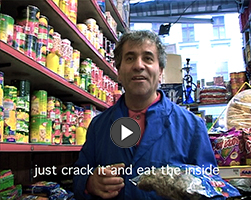Glub, 2004
Shahram Entekhabi with Mieke Bal
PAL video 30 mins., colour, multi-lingual with English subtitles. (Also as eight-channel video installation)
Project assistant: Noa Roei

Shahram Entekhabi with Mieke Bal
PAL video 30 mins., colour, multi-lingual with English subtitles. (Also as eight-channel video installation)
Project assistant: Noa Roei